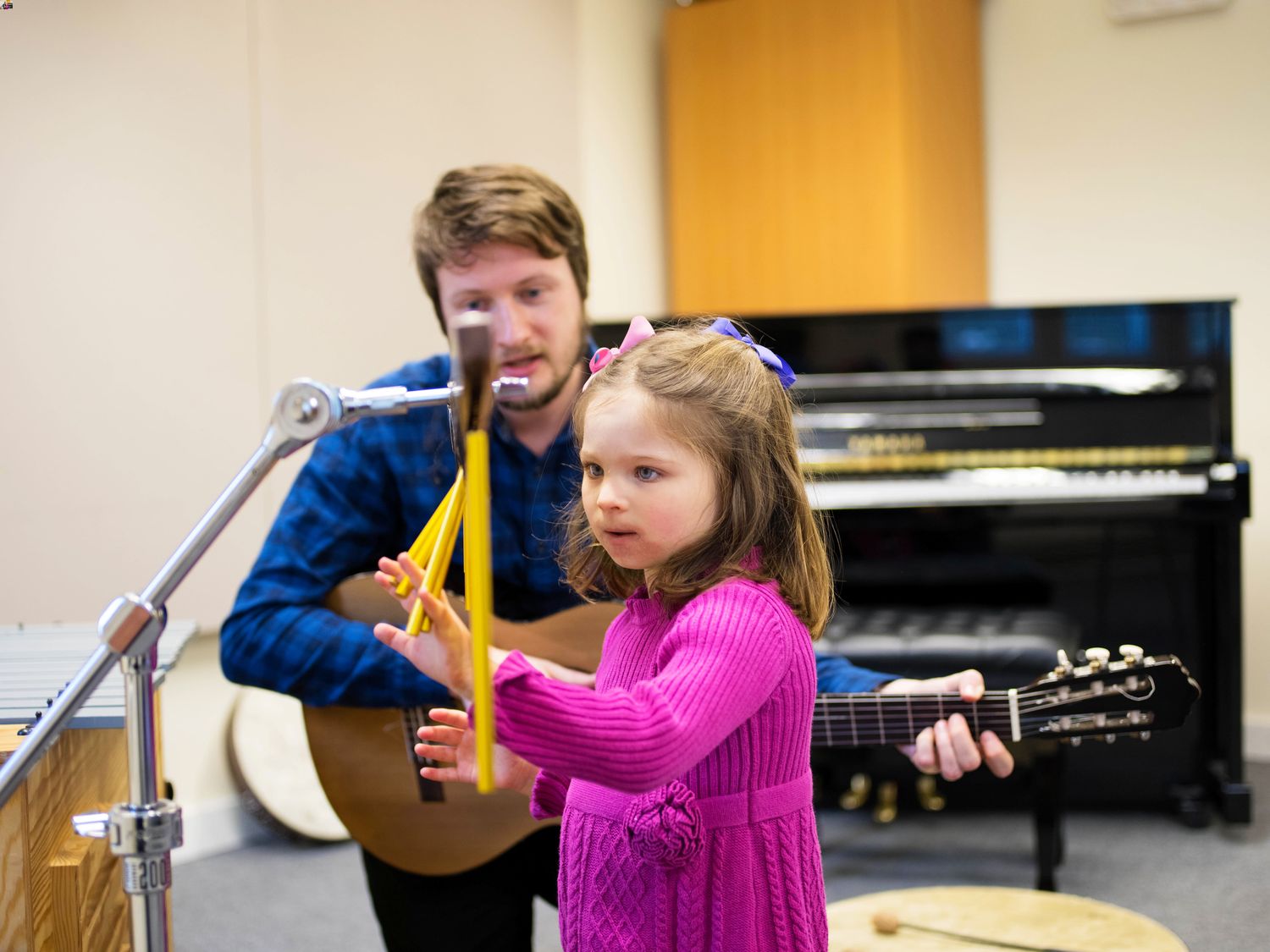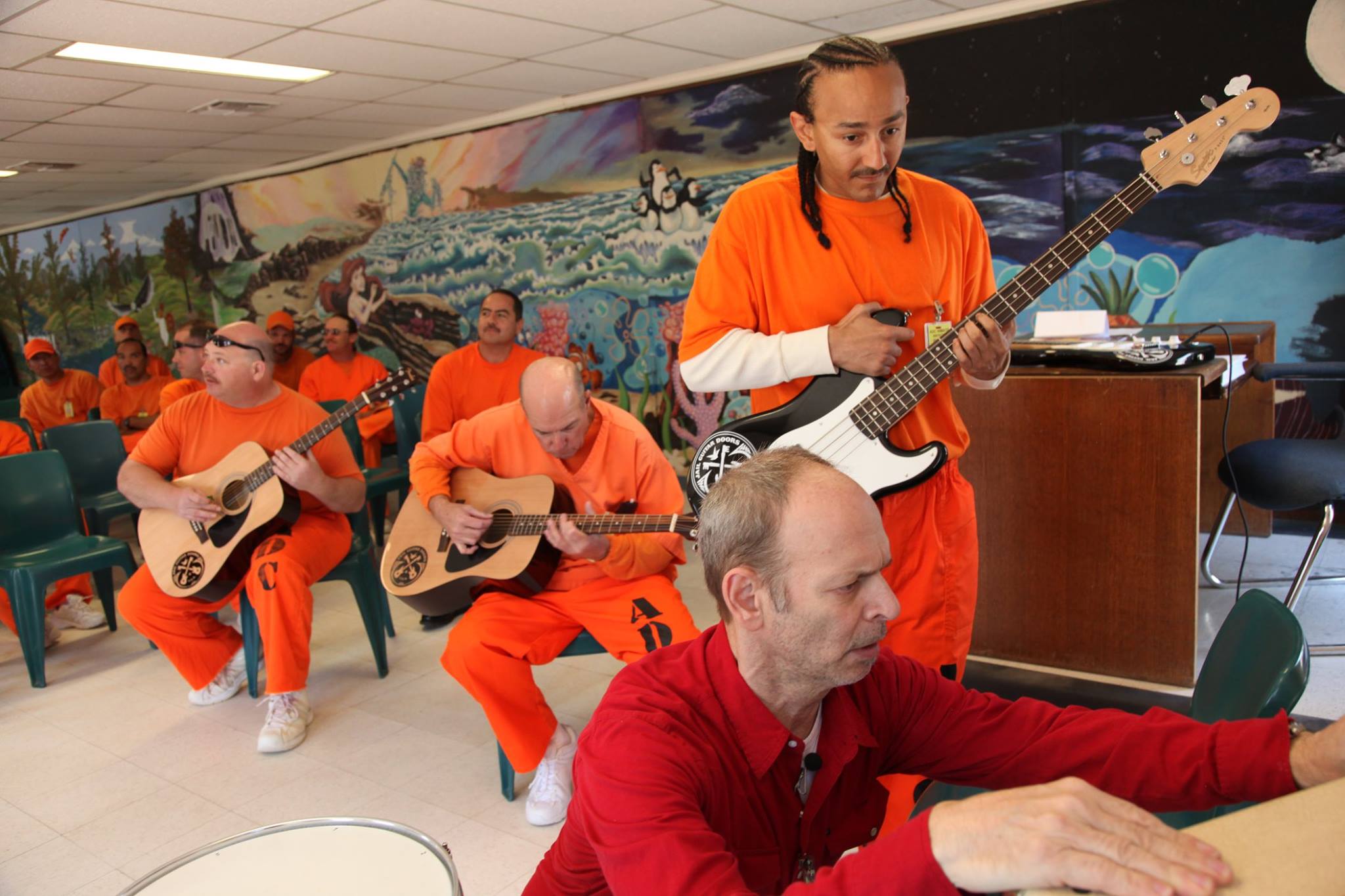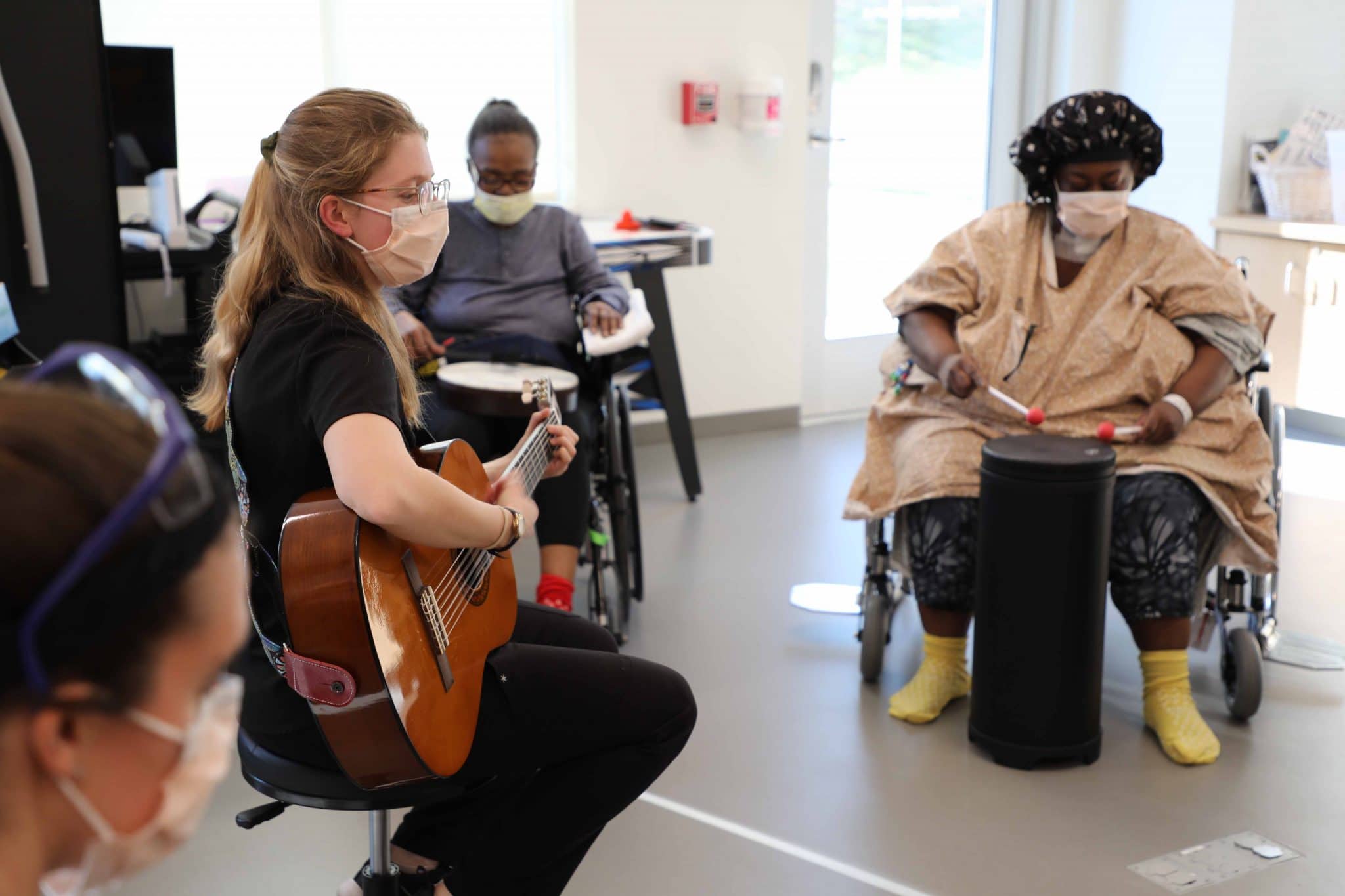Home>Events & Info>Music Therapy>How Much Has Music Therapy Changed


Music Therapy
How Much Has Music Therapy Changed
Modified: March 9, 2024
Explore the transformative power of music therapy and discover how it has revolutionized the healing process. Learn the impact and benefits of music therapy today.
(Many of the links in this article redirect to a specific reviewed product. Your purchase of these products through affiliate links helps to generate commission for AudioLover.com, at no extra cost. Learn more)
Table of Contents
- Introduction
- Origins of Music Therapy
- Early Applications of Music Therapy
- Evolution of Music Therapy Practices
- Current Approaches in Music Therapy
- Impact of Music Therapy on Mental Health
- Music Therapy in Medical Settings
- Music Therapy in Special Education
- Music Therapy in Palliative Care
- Advancements in Technology and Music Therapy
- Challenges and Future Directions in Music Therapy
- Conclusion
Introduction
Music has always had a profound impact on our emotions, providing comfort, evoking memories, and fostering connections. It is no surprise, then, that music holds therapeutic power, capable of improving our mental, emotional, and physical well-being. This is the essence of music therapy, a field that has gained recognition and credibility over the years.
Music therapy is an evidence-based practice that uses music interventions to address the physical, emotional, cognitive, and social needs of individuals. It involves the deliberate use of music by trained therapists to achieve specific treatment goals and promote overall wellness. This holistic approach recognizes the innate power of music to engage, inspire, and heal.
The origins of music therapy can be traced back to ancient civilizations, where music was used for healing rituals and spiritual purposes. In ancient Greece, for example, music was believed to have the ability to restore balance and harmony to the mind and body.
Over time, the field of music therapy has evolved, adapting to changing societal needs and incorporating advances in scientific research. With a strong foundation in psychology, neuroscience, and music theory, music therapy is now recognized as a valuable adjunct to traditional therapeutic approaches.
In this article, we will explore the origins, applications, and advancements in music therapy. We will delve into the various approaches used in music therapy and examine its impact on mental health, medical settings, special education, and palliative care. We will also discuss the role of technology in enhancing music therapy practices and explore the challenges and future directions of this dynamic field.
Join us on this journey as we explore how music therapy has evolved and how it continues to shape the lives of individuals around the world.
Origins of Music Therapy
The roots of music therapy can be traced back to ancient civilizations, where the healing power of music was revered. In ancient Egypt, for example, music was used in the treatment of mental disorders. The Greek philosopher Pythagoras believed that music could influence the body and the soul, and thus used music to promote healing.
The modern practice of music therapy, however, began to take shape in the early 20th century. It was during World War I and World War II that musicians started to visit veterans hospitals and use music to help alleviate physical and emotional pain. These early pioneers recognized the soothing effect of music and how it could provide comfort and solace to those suffering from physical and psychological trauma.
One key figure in the development of music therapy as a profession was Dr. Edwin E. Gordon. In the 1940s, he formed the National Association for Music Therapy, which later became the American Association for Music Therapy (AMTA). This organization played a crucial role in establishing standards and guidelines for the practice of music therapy.
During the 1960s and 1970s, music therapy gained recognition as a legitimate and effective form of therapy. The field began to embrace a more scientific approach, with studies exploring the physiological and psychological effects of music. This research helped solidify the credibility of music therapy and led to its inclusion in healthcare settings.
Today, music therapy is practiced worldwide and is recognized as an established allied health profession. It is supported by an ever-growing body of research that demonstrates its effectiveness across a wide range of populations and conditions.
The origins of music therapy highlight the innate human connection to music and its ability to transcend language and cultural barriers. Music therapy continues to evolve and adapt, drawing from its rich history while embracing innovations in technology and research. As we delve deeper into the applications and impact of music therapy, we will see how it has transformed lives and provided hope and healing to countless individuals.
Early Applications of Music Therapy
Throughout history, music has been used as a form of therapy in various cultures. Early applications of music therapy were often rooted in spiritual and religious practices, where music was believed to have the power to heal and bring about inner peace.
In ancient Greece, music was considered a powerful tool for emotional and physical healing. The renowned physician Hippocrates, often referred to as the father of medicine, recognized the therapeutic benefits of music and used it to treat mental and physical ailments.
During the Renaissance period, music was used as a form of therapy in hospitals and psychiatric institutions. It was believed that certain melodies and rhythms could soothe troubled minds and restore balance to the body.
One notable figure in the early history of music therapy is Father Johann Heinrich Pestalozzi, a Swiss pastor and educator. In the late 18th century, Pestalozzi used music as a means of therapeutic education for children with special needs. He believed that music could enhance their cognitive, emotional, and social development.
Another influential pioneer of music therapy was Dr. Samuel Gridley Howe, who founded the Perkins School for the Blind in the United States in the early 19th century. Driven by his belief in the power of music to stimulate the senses, he introduced music education as an integral part of the curriculum for his students.
During the two World Wars, music therapy gained recognition as a method to aid in the rehabilitation of soldiers suffering from physical and emotional trauma. Musicians visited hospitals and played music for wounded warriors, aiming to provide comfort and promote healing.
As music therapy continued to gain recognition, formal training programs and techniques began to emerge. In the mid-20th century, music therapy programs were established in universities and medical settings, leading to the professionalization and standardization of the field.
The early applications of music therapy laid the foundation for its integration into various healthcare settings and its recognition as a powerful therapeutic tool. Music therapists today draw on these historical practices while incorporating evidence-based techniques to address the unique needs of their clients.
Evolution of Music Therapy Practices
Since its early beginnings, the field of music therapy has undergone significant evolution and transformation. As research and understanding of the therapeutic benefits of music expanded, so did the practices within music therapy.
In the early days, music therapy primarily involved live music interventions, where trained therapists would play instruments or sing to engage individuals in therapeutic processes. These interventions aimed to stimulate emotional expression, facilitate communication, and promote relaxation.
As the field progressed, the focus shifted towards incorporating a more systematic and evidence-based approach. Music therapists began to utilize a wide range of techniques, including improvisation, songwriting, music listening, and music-assisted guided imagery. These techniques allowed for more individualized and targeted treatment plans tailored to specific client needs.
One significant development in the evolution of music therapy practices was the emergence of receptive music therapy. This approach involves using recorded music to elicit emotional responses and facilitate therapeutic experiences. Through careful selection of music, therapists can create playlists that evoke specific emotions or support relaxation.
Another advancement in music therapy practices is the use of group therapy settings. Group music therapy provides opportunities for social interaction, self-expression, and peer support. It allows participants to collaborate and connect through music, fostering a sense of community and belonging.
Technology has also played a pivotal role in the evolution of music therapy practices. The advent of digital music recording and playback technology enabled therapists to create custom playlists tailored to individual client needs, making music therapy more accessible and adaptable.
Furthermore, the integration of technology in music therapy has led to the development of innovative tools and interventions. Music-based apps, virtual reality experiences, and wearable biofeedback devices have expanded the possibilities for music therapy, allowing therapists to deliver personalized and interactive interventions.
As the field of music therapy continues to evolve, there is a growing emphasis on research and evidence-based practice. Studies are being conducted to explore the effects of music therapy on various populations and conditions, contributing to a deeper understanding of the mechanisms by which music promotes healing and well-being.
The evolution of music therapy practices reflects the dynamic nature of the field, continually adapting and incorporating new approaches based on research and emerging technologies. Through these advancements, music therapy continues to enhance the lives of individuals, promoting emotional expression, social connection, and holistic well-being.
Current Approaches in Music Therapy
Music therapy encompasses a range of approaches, techniques, and interventions that can be tailored to address the unique needs and goals of individuals or groups. These approaches combine the therapeutic power of music with the expertise of trained music therapists to promote well-being and facilitate personal growth.
One commonly used approach in music therapy is the Nordoff-Robbins model. Developed by music therapists Paul Nordoff and Clive Robbins, this approach focuses on improvisation and creative musical responses. It emphasizes the client’s active participation in the music-making process, allowing for self-expression and exploration.
Another prominent approach is the Behavioral/Neurologic Music Therapy (BNMT). This approach utilizes structured musical experiences to address cognitive, emotional, and physical challenges. It incorporates elements from neurologic rehabilitation and uses music to stimulate specific brain networks and enhance functional outcomes.
The Guided Imagery and Music (GIM) approach is based on the premise that music can evoke imagery and facilitate deep emotional exploration. Through a series of carefully selected music pieces, clients are guided into a relaxed state where they can access and process their emotions and memories in a safe and supportive environment.
Cognitive-Behavioral Music Therapy (CBMT) combines elements of cognitive-behavioral therapy with music therapy techniques. It aims to help individuals identify and modify negative thought patterns and behaviors through the use of music. This approach can be particularly effective in treating conditions such as anxiety, depression, and substance abuse.
Music therapy in palliative care often involves creating personalized playlists that help individuals find comfort and solace during end-of-life situations. The music therapist works closely with the individual and their loved ones to select meaningful songs that evoke positive memories, provide emotional support, and promote a sense of peace and acceptance.
Person-Centered Music Therapy (PCMT) focuses on building a therapeutic relationship between the therapist and the client. It places emphasis on the individual’s preferences, goals, and experiences, allowing them to take an active role in their own therapy. PCMT recognizes the importance of the therapeutic relationship in facilitating growth and healing.
These are just a few examples of the current approaches in music therapy. Each approach is tailored to suit the unique needs and goals of the individual or group receiving therapy. Music therapists utilize their expertise and a wide range of techniques to create a safe and supportive therapeutic environment, harnessing the power of music to promote healing, self-expression, and personal growth.
Impact of Music Therapy on Mental Health
Music therapy has shown significant positive effects on mental health, offering a powerful and unique approach to support individuals facing various mental health challenges. The therapeutic use of music can help improve emotional well-being, reduce anxiety and stress, enhance self-awareness, and promote self-expression.
One of the key benefits of music therapy is its ability to regulate emotions. Listening to or creating music can evoke powerful emotions and provide a safe outlet for their expression. Music therapists work with clients to identify and work through their emotions, fostering emotional resilience and promoting a sense of catharsis.
Music therapy has been particularly effective in reducing anxiety and stress. Research has shown that listening to calming music or engaging in music-making activities can lower cortisol levels, the hormone associated with stress. The rhythmic and melodic elements of music can induce a relaxation response, promoting a sense of calm and wellbeing.
Moreover, music therapy has been found to alleviate symptoms of depression. Listening to music that resonates with personal experiences and emotions can evoke positive feelings and provide a sense of connection. Music therapy also encourages exploratory songwriting and lyric analysis, empowering individuals to express their deepest emotions and find solace in the creative process.
In addition, music therapy has been widely utilized in the treatment of trauma-related disorders. The use of carefully chosen music and therapeutic techniques can facilitate the processing and integration of traumatic experiences. It can also help individuals learn healthy coping mechanisms, build resilience, and restore a sense of safety and trust.
Music therapy has also proven effective in enhancing cognitive functions and memory in individuals with neurological conditions such as Alzheimer’s disease and dementia. The use of familiar music can evoke memories, stimulate cognitive processing, and improve overall cognitive functioning.
Furthermore, music therapy promotes social interaction and improves communication skills. Group music therapy sessions provide an opportunity for individuals to connect, express themselves, and build meaningful relationships. The collaborative nature of music-making encourages teamwork, empathy, and effective communication among participants.
Overall, music therapy offers a holistic and impactful approach to supporting individuals’ mental health. By harnessing the power of music, trained music therapists work collaboratively with clients to address mental health challenges, improve emotional well-being, and enhance overall quality of life.
Music Therapy in Medical Settings
Music therapy has become an integral part of healthcare, with its significant impact on physical and emotional well-being. In medical settings, music therapy is used to complement traditional medical treatments, providing a therapeutic and supportive environment for patients and their families.
In hospitals, music therapy is utilized to help manage pain and discomfort. Research has shown that listening to music can reduce perceived pain intensity and provide distraction, making medical procedures and treatments more tolerable. Music therapists work closely with patients to select music that resonates with their individual preferences and creates a soothing and relaxing atmosphere.
Music therapy has also been implemented in pediatric settings to alleviate anxiety and promote coping skills among young patients. Engaging in musical activities and interventions can serve as a positive and enjoyable distraction, allowing children to express their emotions and engage in play while receiving medical care.
In cancer treatment centers, music therapy has shown promising results in providing emotional support and improving overall well-being. It can alleviate feelings of stress, anxiety, and depression commonly associated with cancer diagnosis and treatment. Music therapists often collaborate with patients to create personalized playlists, facilitating relaxation and emotional expression.
Furthermore, music therapy is used in rehabilitation settings to support individuals recovering from injuries or undergoing physical therapy. Musical exercises and rhythm-based interventions can help improve motor coordination, balance, and endurance. The rhythmic elements of music provide a structured framework for movement, promoting engagement and motivation during rehabilitation sessions.
Music therapy is also widely utilized in palliative care, offering comfort and solace to individuals nearing the end of life. Therapeutic music interventions can evoke positive memories, foster emotional and spiritual connections, and provide support for individuals and their families during the emotional and challenging end-of-life journey.
Music therapy is a versatile intervention that can be adapted to meet the unique needs of patients in various medical settings. Whether it’s providing relaxation, pain management, emotional support, or rehabilitation, music therapy offers a non-invasive and holistic approach that complements traditional medical treatments and enhances the overall healing experience in medical settings.
Music Therapy in Special Education
Music therapy is a valuable and effective approach in supporting the education and development of individuals with special needs. In special education settings, music therapy is used to enhance communication, social skills, cognitive abilities, and overall quality of life.
One of the primary benefits of music therapy in special education is its ability to engage individuals who may experience challenges in other areas. The use of music as a medium can provide a non-threatening and enjoyable environment for individuals to express themselves and develop their communication skills. Through singing, playing instruments, and engaging in musical activities, music therapists facilitate effective communication and encourage self-expression.
Music therapy also plays a vital role in promoting social interaction and building interpersonal skills. Group music therapy sessions allow individuals to collaborate, take turns, and engage in shared musical experiences. Through these interactions, individuals can develop important social skills, such as listening, turn-taking, and cooperation.
Cognitive abilities can also be enhanced through music therapy in special education. Music engages various areas of the brain, stimulating memory, attention, and problem-solving skills. Music therapists utilize rhythmic patterns, melodic structures, and mnemonic techniques to enhance cognitive processing and promote learning.
Furthermore, music therapy supports emotional development and self-regulation in individuals with special needs. Music has the power to evoke and elicit emotions, providing a safe outlet for individuals to explore and manage their feelings. Music therapists work with individuals to identify and express emotions through music, promoting emotional well-being and enhancing emotional intelligence.
In special education settings, music therapy is also utilized to address motor skills and coordination. Rhythm-based activities, such as drumming or dancing, can improve motor planning, gross and fine motor skills, and overall physical coordination. The repetitive and structured nature of music provides a framework for movement and supports motor development.
The versatile nature of music therapy allows it to be adapted to the unique needs and abilities of each individual in special education. Music therapists work collaboratively with teachers, parents, and other professionals to develop personalized interventions and goals that support each individual’s learning and development.
Music therapy in special education is a powerful tool that harnesses the many benefits of music to support individuals with special needs in reaching their potential and enhancing their overall quality of life. Through music, individuals can develop valuable skills, gain confidence, and experience the joy of self-expression and connection.
Music Therapy in Palliative Care
Music therapy plays a crucial role in palliative care, offering comfort, solace, and support to individuals at the end of life and their families. In palliative care settings, music therapy helps individuals navigate the emotional, physical, and spiritual challenges associated with the dying process.
One of the significant ways in which music therapy impacts palliative care is by providing emotional support. Listening to familiar or meaningful music can evoke positive memories, promote emotional expression, and create a sense of comfort and peace. Music therapists work closely with patients and their families to select music that resonates with their individual preferences and experiences, fostering emotional connection and moments of reminiscence and joy.
Music therapy also addresses the psychological and spiritual well-being of individuals in palliative care. With the help of music, individuals can express their fears, hopes, and regrets, and explore their spiritual beliefs. As a non-verbal and non-intrusive medium, music allows individuals to communicate and process their emotions in a safe and supportive environment.
The presence of music therapists in palliative care settings can also facilitate communication and strengthen relationships within families. Through shared musical experiences, individuals and their loved ones can find comfort and connection, promoting bonding and supporting each other during the end-of-life journey.
Furthermore, music therapy can assist in managing physical symptoms and promoting relaxation in individuals receiving palliative care. The rhythmic elements of music can help regulate breathing and heart rate, induce a state of calm, and alleviate pain and discomfort. Music therapists use specific rhythm patterns and soothing melodies to create a peaceful environment for individuals.
Another important aspect of music therapy in palliative care is its ability to provide a sense of dignity and personal identity. Through songwriting and composing personalized music, individuals can leave a musical legacy, expressing their own unique stories and leaving a lasting imprint for their loved ones.
Overall, music therapy in palliative care recognizes the power of music to ease suffering, provide comfort, and promote emotional and spiritual well-being during the end-of-life journey. By incorporating music therapy into palliative care, patients and their families are supported in experiencing moments of joy, connection, and peace amidst the challenges of this stage of life.
Advancements in Technology and Music Therapy
Advancements in technology have greatly influenced the field of music therapy, opening up new possibilities and expanding the reach of therapeutic interventions. The integration of technology in music therapy has enhanced the accessibility, versatility, and effectiveness of interventions for individuals of all ages and abilities.
One significant advancement is the use of digital music recording and playback technology. Music therapists can create personalized playlists tailored to the specific preferences and needs of their clients. This allows for a more targeted and individualized approach, ensuring that the music used in therapy resonates with the individual on a personal and emotional level.
Technology has also enabled the development of interactive music-making tools and apps. These tools allow individuals to engage with music in a hands-on and interactive manner, regardless of their musical abilities. From simple touch-sensitive instruments to more advanced virtual reality experiences, technology provides opportunities for individuals to explore and create music in a fun and engaging way.
Furthermore, advancements in biofeedback technology have revolutionized the field of music therapy. Wearable devices, such as heart rate monitors or EEG sensors, can provide real-time physiological data. Music therapists can utilize this data to adjust the tempo, rhythm, or style of music in real-time, creating an individualized and adaptive musical experience that promotes relaxation and emotional regulation.
The use of telehealth and online platforms has also expanded access to music therapy services. Individuals who may not have physical access to a music therapist can now engage in remote sessions via video conferencing platforms. This allows for greater reach, particularly in rural or underserved areas, and provides convenient options for individuals with mobility limitations.
Augmented reality (AR) and virtual reality (VR) technologies have also found their way into music therapy. These immersive experiences can create virtual environments where individuals can explore, create, and interact with music in new and unique ways. These technologies can be particularly engaging for individuals with sensory or motor impairments, offering a multi-sensory experience that enhances their overall therapy experience.
Advancements in technology continue to push the boundaries of what is possible in music therapy. From personalized playlists and interactive music-making tools to telehealth services and immersive virtual experiences, technology has revolutionized the practice of music therapy, allowing for more customized, engaging, and accessible interventions that cater to the diverse needs of clients.
Challenges and Future Directions in Music Therapy
While the field of music therapy has made significant advancements, it also faces certain challenges and holds potential for future growth and development. Recognizing these challenges and exploring new directions will help shape the future of music therapy and expand its impact on individuals’ lives.
One challenge in music therapy is the need for continued research and evidence-based practice. While there is a growing body of research supporting the effectiveness of music therapy, there is still a need for more rigorous studies and standardized protocols. Further research will strengthen the evidence base and contribute to the field’s credibility, enabling music therapy to be more widely integrated into healthcare systems.
Another challenge is the limited access to music therapy services, particularly in underserved areas or communities. Increasing access to music therapy will require efforts to train and educate more music therapists, as well as advocating for greater inclusion of music therapy services in healthcare settings and insurance coverage.
The integration of technology in music therapy also presents both opportunities and challenges. While technology has enhanced the accessibility and versatility of music therapy, it is essential to maintain a balance and ensure that technology does not replace the therapeutic relationship and the human connection that is integral to the field. Music therapists must continue to navigate the ethical considerations and use technology as a tool to enhance, rather than replace, their expertise and interventions.
Furthermore, fostering interdisciplinary collaboration is a crucial direction for the future of music therapy. Collaborating with professionals from other disciplines, such as psychology, neuroscience, and medicine, can enrich the therapeutic process and contribute to a more holistic and comprehensive approach. By working together, professionals can exchange knowledge, share research findings, and develop innovative interventions that address the unique needs of individuals more effectively.
In terms of future directions, the integration of cultural diversity and inclusivity is essential. Music therapy must continue to recognize and respect the diverse cultural backgrounds of individuals and tailor interventions accordingly. Cultural sensitivity and the incorporation of diverse musical traditions can enhance engagement and promote the therapeutic outcomes of music therapy.
Additionally, addressing the growing impact of technology in music therapy is a critical aspect of the field’s future. Exploring the use of virtual reality, artificial intelligence, and new digital platforms can expand the reach of music therapy and provide innovative interventions that meet the evolving needs of individuals seeking therapeutic support.
Overall, facing the challenges of research, accessibility, ethical considerations, and interdisciplinary collaboration while embracing future directions in cultural inclusivity and technological advancements will shape the future of music therapy. By addressing these challenges and exploring new possibilities, music therapy can continue to evolve and make a meaningful impact on individuals’ well-being and overall quality of life.
Conclusion
Music therapy has transformed from an ancient healing practice to a recognized and respected allied health profession. It has proven to be a powerful tool in addressing physical, emotional, and cognitive needs, impacting various settings and populations.
From its origins in ancient civilizations to its current practices, music therapy has evolved and adapted to meet the changing needs of individuals. The field has embraced advancements in technology, incorporating digital tools and telehealth services to enhance accessibility and effectiveness.
In mental health settings, music therapy has shown profound effects, providing emotional support, managing anxiety and stress, and promoting self-expression. In medical settings and special education, music therapy has become an integral part of holistic care, allowing individuals to navigate physical and cognitive challenges while fostering social connection and personal growth.
Palliative care has also benefited greatly from music therapy, offering solace, emotional support, and dignity during end-of-life journeys. Through personalized music interventions, individuals and their families find comfort and connection, promoting a sense of peace and acceptance.
As music therapy faces challenges such as the need for further research, access limitations, and ethical considerations, it also opens up exciting future directions. Cultivating interdisciplinary collaboration, embracing cultural diversity, and exploring innovative technological applications will shape the future of music therapy and expand its reach.
Ultimately, music therapy harnesses the therapeutic power of music to enhance lives, promote well-being, and facilitate healing. Its ability to transcend language and culturally connect individuals underscores its universal appeal. With its evidence-based practices, personalized interventions, and human connection, music therapy continues to make a profound impact on individuals of all ages and abilities.
As we move forward, let us continue to recognize and harness the therapeutic potential of music, and advocate for the integration of music therapy services within healthcare systems. Through continued research, innovation, and collaboration, music therapy will undoubtedly continue to grow and positively transform the lives of individuals around the world.











